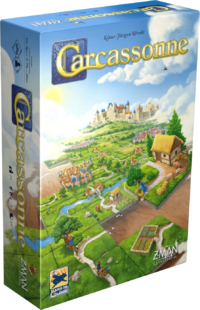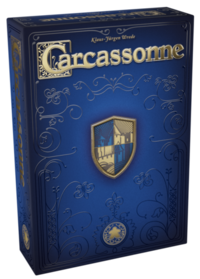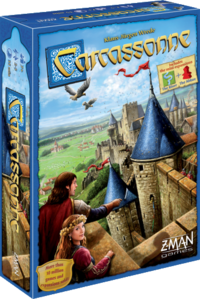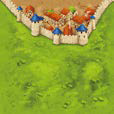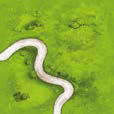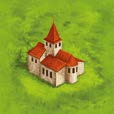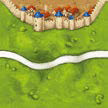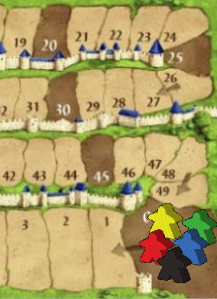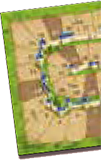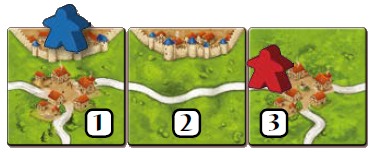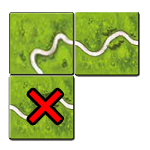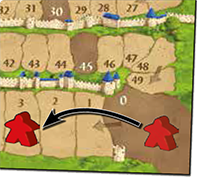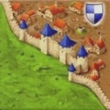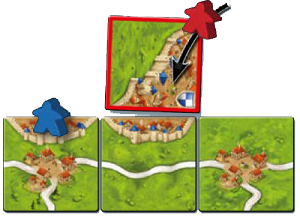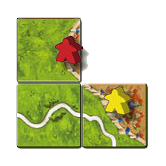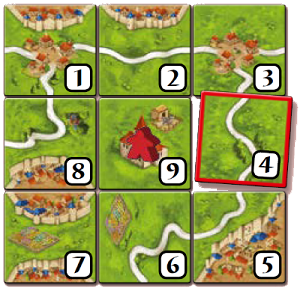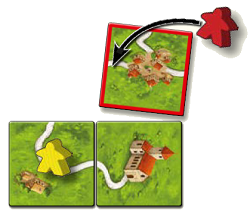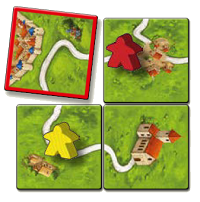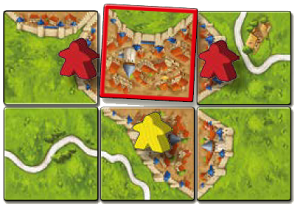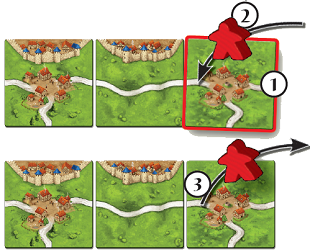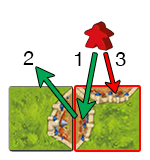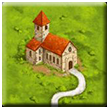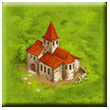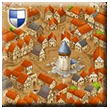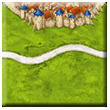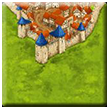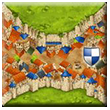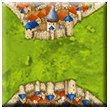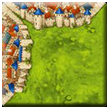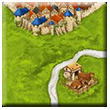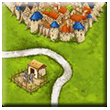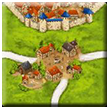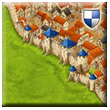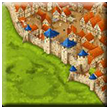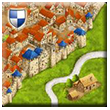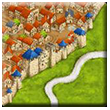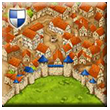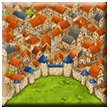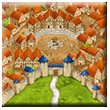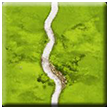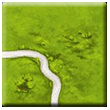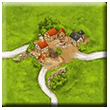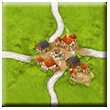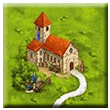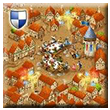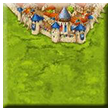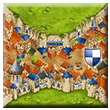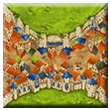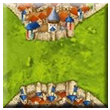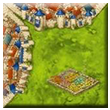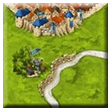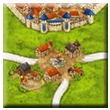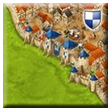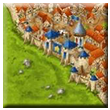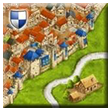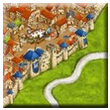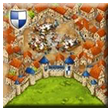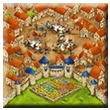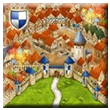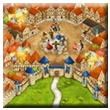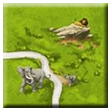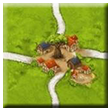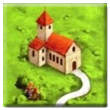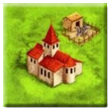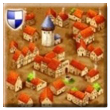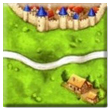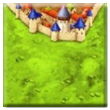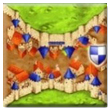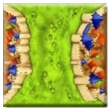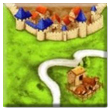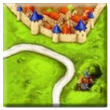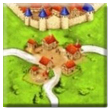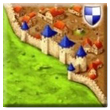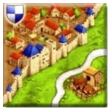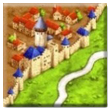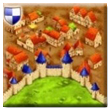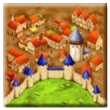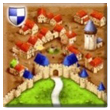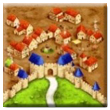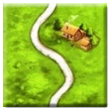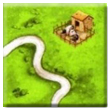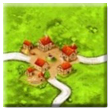Base game
 |
You are reading the rules for this tile design. |  |
 | Read the following rules if your tiles look like this. |
| If your tiles have a different design, then choose a game from Spin-offs. |  |
General info and comments
Originally released by Hans im Glück in 2014, this second edition of the game is known as C2 for short. A 20th Anniversary Edition was released in 2021 including some celebratory elements that do not affect the rules. A third edition, known as C3 for short, was released in 2021 including more detailed graphics and some minor wording changes.
Copies printed in C2 in the period 2014-2016 have the darker city backgrounds. The 20th Anniversary Edition and Carcassonne C3 have cities with clipped buildings.
The game was released in its first edition, known as C1 for short, in 2000. This edition includes some variations in wording, if compared with later editions, and a different graphic style. However, all the editions are compatible.
Carcassonne, the world-famous French city, is known for its imposing fortifications erected during Antiquity and the Middle Ages. This fortress, surrounded by magnificent walls, still stands today as one of the most unique French cities. In this game, players must develop the area around Carcassonne. They place their meeples onto roads and into cities, monasteries, and fields. Only those who make the most judicious placements will gain the points required to win the game.
Info on farmers rules
Farmers are considered a part of the base game for most Carcassonne players. They are also used in every official tournament as they are commonly not considered an expansion. In C2 and later editions, farmers were separated as a supplement to ease access to the game for new players and smooth learning curve. WikiCarpedia follows this streamlined approach. For the sake of other expansions and the rest of the WikiCarpedia, farmers are considered a part of the base game. You can find farmers rules here.
Components and setup
Following part will explain initial setup and introduce components of the game.
The 72 LANDSCAPE TILES show roads, cities, and monasteries, in a field.
The backs of all the tiles are the same, but the START TILE has a darker colored back, so you can recognize it easily. Other graphical elements such as houses, people, or animals have no impact on the game. [1]
Place the start tile (the one with a dark back) in the middle of the table. Shuffle the remaining tiles and set them as different facedown stacks that are easily accessible to all players. Tiles can also be placed into a sack or game box and drawn randomly.
Then comes the scoreboard, which you set to the side of your playing surface (table, floor, etc.).
Finally, we have the MEEPLES. You will find in the box 40 regular meeples, including 8 meeples in each of these colors: yellow, red, green, blue, and black. [2] In addition, there are also 5 abbots. Usage of abbots is described in ![]() The Abbot mini expansion page, including 1 in each of the same colors. Abbots are not important from base game point of view.
The Abbot mini expansion page, including 1 in each of the same colors. Abbots are not important from base game point of view.
Start by distributing 7 meeples of the color of their choice to each player. These meeples constitute each player’s personal supply. Each player takes seven meeples of their chosen color to form their supply. Place each player's eighth meeple on the 0 space on the scoreboard. These will be used to track each player's score throughout the game. If you are not playing with ![]() The Abbot, put those unique meeples back into the box.
The Abbot, put those unique meeples back into the box.
![]() Question: Too few followers—are we playing wrong or are there really too few?
Question: Too few followers—are we playing wrong or are there really too few?
Overview and goal of the game
In Carcassonne, players take turns placing tiles and expanding the landscape of roads, cities, monasteries and fields, one tile at a time. Players may place their meeples on the individual features of tiles as well (roads, cities, monasteries, and fields), where they will become highwaymen, knights, monks and farmers. Points are earned throughout the game, and the player with the highest score at the end is the winner!
| Changes to the 20th Anniversary Edition and Carcassonne C3
The rules for the 20th Anniversary Edition and Carcassonne C3 stay the same but the roles of some meeples have been updated:
Publishers have followed the new roles provided in the rules by HiG, although some of these changes are not noticeable in other languages. Note: We stick to the classic role convention for the sake of consistency with all the exisiting rules for the time being. HiG may decide to update the rules in the future to follow this new naming convention for new releases and reprints. |
Gameplay
A game of Carcassonne is played in clockwise order. Starting with the youngest player, [3] [4] the current player does the following actions in the order listed below, after which it is the next player's turn, and so on and so forth. First, we'll give you a brief description of the actions you have to do during one of your turns. These actions will be detailed as we present the roads, the cities, and finally the monasteries. So what are these actions?
1. Placing a tile
| The player must draw exactly one land tile from a stack and place it faceup adjacent to any tile already on the board to continue the landscape. [5] |
The roads
1. Placing a tile
You draw the depicted tile with three road segments starting from a village. You must place it in such a way that it continues the existing landscape (the tiles already in play). In the rare case that a tile cannot legally be placed anywhere, and all players agree, it is removed from the game, and the player draws another. [6] [7]
2. Placing a meeple as highwayman
After placing the tile, you may place a meeple as a highwayman on one of that tile’s road segments, but only if the road is unoccupied by another highwayman.
In our example, since the road is not yet completed, no scoring occurs (see action 3) and play moves on to the next player.
The next player draws a tile that he/she places to continue the landscape. They may not place a meeple on the road to the right since your highwayman is already present on that road. Instead, they choose to place their meeple as a knight in the city segment of that tile.
3. Scoring a road
When both ends of a road are closed, that road is completed and scored. The end of a road is closed when it meets a village, [8] a city, a monastery, or it loops onto itself by meeting the other end. [9]
![]() Question: Can a road end in nothing?
Question: Can a road end in nothing?
Even though it is your opponent that placed the tile, this still completes your road. How many points do you score? When scoring a road, each tile of that road grants you 1 point. Here, since you scored a road that is made out of 3 tiles, you score 3 points.
It is now time to note your score. You keep track of your score with the meeple you placed on the scoreboard before starting the game. Continuing our example, you move it forward 3 spaces to show that you’ve scored 3 points. Note: if your score passes 50 points, lay down your scoring meeple to show your 50+ points.
After scoring, return any meeples that occupy the road that was just scored to their owners' supply.
We’ve already seen the most important parts of the game. Now, we will further expand on those actions by showing you how they apply to the other features, namely the cities and the monasteries:
The cities
1. Placing a tile
2. Placing a meeple as a knight
Then, you see if there is already a meeple as a knight in the city. Here, there isn’t, so you can place one of your meeples as a knight in this city.
3. Scoring a city
Let’s continue our example and assume that a few turns have passed. You now draw this tile that you place to continue your city. Since the tile you’ve placed completes a feature (here, the city), it must now be scored. A city is completed when it is surrounded by walls and there are no gaps inside the city. Since you have a meeple in the completed city, you are the player to score it.
Each tile in a completed city is worth 2 points. In addition, each coat of arms is worth 2 more points. [10] For this city, you score 8 points! As usual, the meeple that was in the scored feature returns to your supply.
The monasteries
1. Placing a tile
2. Placing a meeple as a monk
3. Scoring a monastery
A monastery is completed when it is surrounded by tiles. During scoring, the monastery is worth 1 point per tile that completes it (including the monastery itself).
By placing this tile, you complete your monastery. It earns you 9 points and allows you to take your meeple back.
We have already seen most of the rules for Carcassonne. There are only a few points left to see, but first, here is a summary of what we’ve seen so far:
Summary
1. Placing a tile
- You must place your drawn tile in such a way that it continues the landscape and the illustration.
- In some very rare cases, it may be impossible to place the tile. In those cases, simply return the tile to the box and draw a new one. [6]
2. Placing a meeple
- You may place a meeple on the tile you’ve just placed.
- You may not place a meeple in a feature where there already is at least one other meeple, including one of yours.
3. Scoring a feature
- A road is completed when both ends lead to a village, a city, a monastery, or the road forms a loop. Each tile in a completed road is worth 1 point.
- A city is completed when it is surrounded by walls and there are no holes inside the city. Each tile in the completed city is worth 2 points. Each coat of arms in the completed city is worth an extra 2 points.
- A monastery is completed when it is surrounded by 8 tiles. Each of the monastery’s tiles (the 8 surrounding tiles and the one with the monastery itself) is worth 1 point.
- Scoring always occurs at the end of a player’s turn. At that moment, each player with a meeple in a scored feature earns points. [13]
- After each scoring, return the scored meeples to their owners' supply.
- If there are multiple meeples in a single scored feature, the player with the most meeples is awarded full points and all other players receive nothing. When more than one player have the most meeples in a scored feature, the tied players all score full points.
Game end and final scoring
The game ends as soon as a player can no longer draw and place a landscape tile. [14] Then, players proceed to a final scoring, after which the winner will be known.
Once the game is over, all meeples still in play are scored:
- Each incomplete road is worth 1 point per tile, just like during the game.
- Each incomplete city is worth 1 point per tile and 1 point per coat of arms, which is only half the points.
- Each incomplete monastery is worth 1 point plus 1 point per adjacent tile, just like during the game.
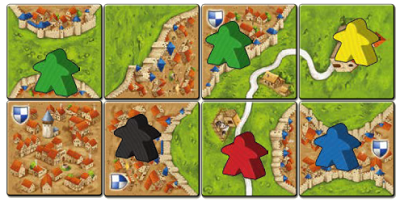
- Left city: Green is the only one to score 8 points (5 tiles and 3 coat of arms). Black does not score any points since Green has the most meeples in this city.
- Monastery: Yellow scores 4 points for this incomplete monastery (3 points for the adjacent tiles and 1 point for the monastery itself).
- Right city: Blue scores 3 points for this incomplete city (2 tiles and 1 coat of arms).
- Road: Red scores 3 points for this incomplete roads (3 tiles).
Once the final score is known, the winner is the player with the most points.[15]
Special cases
Many meeples on the same road
Many meeples in the same city
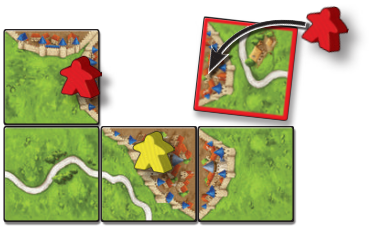
Use a meeple, score a feature, and get the meeple back
You can place a meeple in a feature you just completed, immediately score it, and then return the meeple to your supply.
To do so, follow these steps: [16]
__ 1. Place a tile, completing a feature (such as a road, city, or monastery).
__ 2. Place a meeple as a highwayman, knight, or monk on the feature you just completed.
__ 3. Score the completed road, city, or monastery and return the meeple to your supply.
![]() Question: There is a situation that puzzles us. If a player draws a tile with two city segments and completes a small city, earning 4 points, can he or she then deploy a meeple to a new city segment in the same turn?
Question: There is a situation that puzzles us. If a player draws a tile with two city segments and completes a small city, earning 4 points, can he or she then deploy a meeple to a new city segment in the same turn?
Variants
There are a number of variants for the base game, which modify or redefine the rules of the game to achieve different effects. In the early years of the game, expansions were not so common and many fans started to explore alternative rules to exploit the game's potential. HiG noticed and posted many of these variants on their website for several years.
You can find more information about these variants here.
House rules
![]() The players decide who starts the game by any method they choose—such as by rolling three meeples. The first player to ‘roll’ a standing meeple decides who plays first. (Thanks to Joff.)
The players decide who starts the game by any method they choose—such as by rolling three meeples. The first player to ‘roll’ a standing meeple decides who plays first. (Thanks to Joff.)
![]() To determine the first player; each player draws a tile from the bag, the player that drew the tile with the most roads (0 to 4) plays first, if there is a tie for most roads, a draw-off takes place. This is repeated until someone wins. (Thanks to michael.)
To determine the first player; each player draws a tile from the bag, the player that drew the tile with the most roads (0 to 4) plays first, if there is a tie for most roads, a draw-off takes place. This is repeated until someone wins. (Thanks to michael.)
![]() Take your next tile at the end of your turn, to give you time to think about placement and avoid analysis paralysis.
Take your next tile at the end of your turn, to give you time to think about placement and avoid analysis paralysis.
![]() Play with a three-tile hand. The abbey counts as part of your hand. Play your turn, including the builder, and then draw back up to three tiles. These tiles could be visible to all or hidden to the other players (Thanks to DavidP and youtch.)
Play with a three-tile hand. The abbey counts as part of your hand. Play your turn, including the builder, and then draw back up to three tiles. These tiles could be visible to all or hidden to the other players (Thanks to DavidP and youtch.)
![]() When playing with a bag for the tiles, the original starting tile may be put into the bag, and unplayable tiles can be put back into the bag rather than set to one side. (Thanks to dwhitworth.)
When playing with a bag for the tiles, the original starting tile may be put into the bag, and unplayable tiles can be put back into the bag rather than set to one side. (Thanks to dwhitworth.)
![]() Trees (bushes) on roads do not end the road—only houses do (when the road forks). This makes road building a lot more dynamic. (Thanks to Tobias.)
Trees (bushes) on roads do not end the road—only houses do (when the road forks). This makes road building a lot more dynamic. (Thanks to Tobias.)
![]() When a tile is the only tile which can currently complete a structure, other players can offer to ‘buy’ it by offering points, trades counter, abbey, and so on. (Thanks to Deatheux.)
When a tile is the only tile which can currently complete a structure, other players can offer to ‘buy’ it by offering points, trades counter, abbey, and so on. (Thanks to Deatheux.)
![]() If you place a tile that fills a hole in the playing field by touching something on all four adjacent sides, you get another turn. This helps motivate people to finish the board even if they do not get an advantage from the placement. (Does not apply to the abbey tile). (Thanks to viberunner.)
If you place a tile that fills a hole in the playing field by touching something on all four adjacent sides, you get another turn. This helps motivate people to finish the board even if they do not get an advantage from the placement. (Does not apply to the abbey tile). (Thanks to viberunner.)
![]() Incomplete features at the end of the game do not score points at the end of the game. (Thanks to metoth.)
Incomplete features at the end of the game do not score points at the end of the game. (Thanks to metoth.)
![]() The edge of the table limits the playing area. Thus, a player may not place a tile past the edge of the table or move the playing area to place a tile that would have been past the edge of the table. (Thanks to metoth for prompting this one, and to SkullOne for pointing out that this is an official rule from Hunters and Gatherers.)
The edge of the table limits the playing area. Thus, a player may not place a tile past the edge of the table or move the playing area to place a tile that would have been past the edge of the table. (Thanks to metoth for prompting this one, and to SkullOne for pointing out that this is an official rule from Hunters and Gatherers.)
![]() Table borders COMPLETE features as an abbey would. (Thanks to PreGy.)
Table borders COMPLETE features as an abbey would. (Thanks to PreGy.)
![]() Use colored dice instead of meeples on the scoring track. Start out with the 6 showing on top. When the marker completes one lap, turn it to the number 1 to indicate it has completed one lap. This shows at a glance which player is on what lap and who's ahead. On the 100 space track it’s even easier to determine someone’s score at a glance. (Thanks to Carcking.)
Use colored dice instead of meeples on the scoring track. Start out with the 6 showing on top. When the marker completes one lap, turn it to the number 1 to indicate it has completed one lap. This shows at a glance which player is on what lap and who's ahead. On the 100 space track it’s even easier to determine someone’s score at a glance. (Thanks to Carcking.)
Use of a table
A number of questions have been asked about rules related to the play area itself, including what happens when the edge of the area is reached, or if a table has to be used for play. The following clarifications are from Georg Wild from HiG (5/2013):
- The edge of the table is the limit for the game if, as stated in the rules, a table is used.
- The rules state that the starting tile is placed in the middle of the table. If all of the tiles are shifted to allow more room, the starting tile would no longer be in the middle. So in principle, total shifting of the tiles is not allowed. Additionally, with a manual shift of all of the tiles, the tiles and figures on the field can slip, which could lead to incorrect positioning of tiles or figures.
- Addition of a second table is possible if one of an appropriate height is added to the first table. If a table is extended (as with an additional panel), make sure that the tiles and figures on the playing field do not slip.
- Playing on the floor: The rules technically do not allow this, because the rules state that the first tile is placed in the middle of the table. Playing on the floor is not forbidden, however, if use of a table is not feasible. If the floor is used, tiles must be placed so all tiles are visible to all players. Tiles cannot be placed under the sofa, cabinet/shelf, etc.
- It is important generally, that all the players in the round agree how to play:
- Table - Standard
- Table - with "total shifting" of tiles
- Table - with extension
- Floor
- Continue to play fairly and not intentionally unfair to other players.
Tile distribution
C3 Edition
This edition replaces one pigsty for one cowshed in the tiles marked with *.
20th Anniversary Edition
The 20th Anniversary Edition includes some celebratory details besides the glossy UV-printing:
- The highwaymen by the roads usually look a bit different, but they can also join the party (maybe they will be a bit more peaceful in the future...). In case you play with an expansion that use them, they will count as normal highwaymen, as usual.
- There are also additional details on the tiles, such as people partying everywhere, as well as hidden many so-called "Easter eggs". These make reference to other Carcassonne or HiG games. All these details have no effect on the rest of the game.
C2 Edition
Footnotes
For Icons explanation and licensing please visit Icons page.
- ↑
 They have no impact considering the base rules. Some of them are used in some expansions, such as
They have no impact considering the base rules. Some of them are used in some expansions, such as  The Markets of Leipzig or
The Markets of Leipzig or  The Tollkeepers.
The Tollkeepers.
- ↑
 The
The  Big Box 6 includes the sixth player, in pink color, as part of the base game and not at
Big Box 6 includes the sixth player, in pink color, as part of the base game and not at  Exp. 1 - Inns & Cathedrals. This makes the rules clearer.
Exp. 1 - Inns & Cathedrals. This makes the rules clearer.
- ↑
 The ZMG rules of the base game mention the "first player" without explaining how it is decided. However, the
The ZMG rules of the base game mention the "first player" without explaining how it is decided. However, the  Big Box 6 rules are re-aligned with the HiG rules and indicate the first player is the youngest one.
Big Box 6 rules are re-aligned with the HiG rules and indicate the first player is the youngest one.
- ↑
 It is common practice to choose starting player at random. More on this in house rules section.
It is common practice to choose starting player at random. More on this in house rules section.
- ↑
 A newly placed land tile must fit the adjacent terrain on all edges! During placement it is not enough to look for only one side that fits.
A newly placed land tile must fit the adjacent terrain on all edges! During placement it is not enough to look for only one side that fits.
- ↑ 6.0 6.1
 Alternatively, if legal, the player could place the abbey tile (
Alternatively, if legal, the player could place the abbey tile ( Exp. 5 - Abbey & Mayor) instead of drawing another tile. (1/2013)
Exp. 5 - Abbey & Mayor) instead of drawing another tile. (1/2013)
 By extension, other tiles in the player's supply could be chosen: a German castle (
By extension, other tiles in the player's supply could be chosen: a German castle ( Castles in Germany) or a Halfling tile (
Castles in Germany) or a Halfling tile ( Halflings).
Halflings).
- ↑
 If drawing tiles out of a bag, a tile that cannot be placed could be returned to the bag for later use.
If drawing tiles out of a bag, a tile that cannot be placed could be returned to the bag for later use.
- ↑
 Village is a little set of red roofed buildings surrounding the crossroad.
Village is a little set of red roofed buildings surrounding the crossroad.
- ↑
 This list is valid in general terms and should be considered open ended. Some expansions incorporate additional features that may end a road, such as groups of trees and bushes, cottages, lakes, various types of ecclesiastical buildings, castles, etc.
This list is valid in general terms and should be considered open ended. Some expansions incorporate additional features that may end a road, such as groups of trees and bushes, cottages, lakes, various types of ecclesiastical buildings, castles, etc.
- ↑
 Note that a coat of arms only affects the city segment it is in, not the whole tile (if there is more than one segment on a single tile).
Note that a coat of arms only affects the city segment it is in, not the whole tile (if there is more than one segment on a single tile).
- ↑
 Monasteries are always located in the center of a tile, so when you place a monastery you must continue the existing other landscape features. Monasteries tend to be surrounded by fields, so monastery tiles normally have field and road edges. In some expansions, we may also find monastery tiles with city edges, and even monasteries within cities.
Monasteries are always located in the center of a tile, so when you place a monastery you must continue the existing other landscape features. Monasteries tend to be surrounded by fields, so monastery tiles normally have field and road edges. In some expansions, we may also find monastery tiles with city edges, and even monasteries within cities.
- ↑
 Monasteries can be placed directly next to each other, or corner to corner. It is not necessary for there to be eight other (non-monastery) tiles neighbouring a monastery. A monastery stands in the middle of a field segment and other segments can be placed next to it. In contrast to roads, cities, and fields, it is not possible to connect to a monastery.
Monasteries can be placed directly next to each other, or corner to corner. It is not necessary for there to be eight other (non-monastery) tiles neighbouring a monastery. A monastery stands in the middle of a field segment and other segments can be placed next to it. In contrast to roads, cities, and fields, it is not possible to connect to a monastery.
- ↑
 When two meeples of one color are occupying the same road, city, or field, you do not score double in these cases. The number of meeples (or in
When two meeples of one color are occupying the same road, city, or field, you do not score double in these cases. The number of meeples (or in  Exp. 1 - Inns & Cathedrals the size of the meeples) has no effect on the points that a player earns from a road, city, monastery, or field. Two knights do not double the points. The number of meeples is only important in establishing who has the majority.
Exp. 1 - Inns & Cathedrals the size of the meeples) has no effect on the points that a player earns from a road, city, monastery, or field. Two knights do not double the points. The number of meeples is only important in establishing who has the majority.
- ↑
 The ZMG rules state the following, which lead to certain interpretation issues when dealing with some expansions:
"The game ends immediately after the turn of the player who placed the last tile."
The ZMG rules state the following, which lead to certain interpretation issues when dealing with some expansions:
"The game ends immediately after the turn of the player who placed the last tile."
- ↑
 Rules do not include tiebreakers. That is rules explaining situation when few players share the same score.
Rules do not include tiebreakers. That is rules explaining situation when few players share the same score.
- ↑
 Note that features are considered to be complete as soon as the tile is placed, although meeple placement and scoring only occur afterwards. This is important when playing with magic portals (
Note that features are considered to be complete as soon as the tile is placed, although meeple placement and scoring only occur afterwards. This is important when playing with magic portals ( Exp. 3 - The Princess & the Dragon) or flying machines (
Exp. 3 - The Princess & the Dragon) or flying machines ( Mini #1 - The Flying Machines).
Mini #1 - The Flying Machines).
